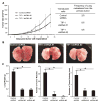The PDZ protein TIP-1 facilitates cell migration and pulmonary metastasis of human invasive breast cancer cells in athymic mice
- PMID: 22564736
- PMCID: PMC3361580
- DOI: 10.1016/j.bbrc.2012.04.123
The PDZ protein TIP-1 facilitates cell migration and pulmonary metastasis of human invasive breast cancer cells in athymic mice
Abstract
Tax-interacting protein 1 (TIP-1, also known as Tax1bp3) inhibited proliferation of colon cancer cells through antagonizing the transcriptional activity of beta-catenin. However, in this study, elevated TIP-1 expression levels were detected in human invasive breast cancers. Studies with two human invasive breast cancer cell lines indicated that RNAi-mediated TIP-1 knockdown suppressed the cell adhesion, proliferation, migration and invasion in vitro, and inhibited tumor growth in mammary fat pads and pulmonary metastasis in athymic mice. Biochemical studies showed that TIP-1 knockdown had moderate and differential effects on the beta-catenin-regulated gene expression, but remarkably down regulated the genes for cell adhesion and motility in breast cancer cells. The decreased expression of integrins and paxillin was accompanied with reduced cell adhesion and focal adhesion formation on fibronectin-coated surface. In conclusion, this study revealed a novel oncogenic function of TIP-1 suggesting that TIP-1 holds potential as a prognostic biomarker and a therapeutic target in the treatment of human invasive breast cancers.
Copyright © 2012 Elsevier Inc. All rights reserved.
Figures




References
-
- Geyer FC, Lacroix-Triki M, Savage K, Arnedos M, Lambros MB, MacKay A, Natrajan R, Reis-Filho JS. beta-Catenin pathway activation in breast cancer is associated with triple-negative phenotype but not with CTNNB1 mutation. Mod Pathol. 2011;24:209–231. - PubMed
-
- Wang X, Goode EL, Fredericksen ZS, Vierkant RA, Pankratz VS, Liu-Mares W, Rider DN, Vachon CM, Cerhan JR, Olson JE, Couch FJ. Association of genetic variation in genes implicated in the beta-catenin destruction complex with risk of breast cancer. Cancer Epidemiol Biomarkers Prev. 2008;17:2101–2108. - PMC - PubMed
-
- Besser J, Leito JT, van der Meer DL, Bagowski CP. Tip-1 induces filopodia growth and is important for gastrulation movements during zebrafish development. Dev Growth Differ. 2007;49:205–214. - PubMed
Publication types
MeSH terms
Substances
Grants and funding
LinkOut - more resources
Full Text Sources
Other Literature Sources
Medical
Research Materials

